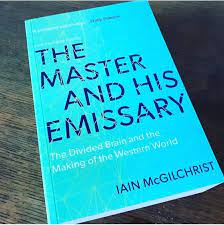Gary Peterson - February 26, 2024
(The first six postings of the blog serve as an introductory set.)
If you are new to the hemisphere hypothesis, I have tried to summarize some key points which should aid in understanding the next several postings. If you are familiar with McGilchrist’s work, it is best to consider this as an elevator ride explanation that tries to summarize his groundbreaking work.
Back in the 1970s or so, a popular belief arose in psychology that people could be classified as either left brain or right brain. It was a simple idea, that science and reason were the domain of left hemisphere and that art and intuition were the domain of the right hemisphere. This was proved wrong. It is now accepted that both brain hemispheres contribute to all of them, but in consistently different ways and to different degrees.
Instead of what each brain hemisphere does, it is better to think of how each hemisphere approaches the world. According to McGilchrist:
“One of the most durable generalizations about the hemispheres has been the finding that the left hemisphere tends to deal more with pieces of information in isolation, and the right hemisphere with the entity as a whole, the so-called Gestalt…”
Evolution supports this development of two different ways of seeing the world. For example, one kind of attention is needed to gather and eat food. One must focus on details and specific tasks, especially in a competitive environment. At the same time, while focused on one’s own food, one must not become someone else’s meal. This requires a different kind of attention that takes in all aspects of the surrounding environment, the big picture, the energy flow of Now, the Gestalt.
As our brains grew and our cognitive abilities increased, the brain hemispheres became increasing differentiated, specialized and independent. As a result, large portions of the left brain hemisphere stopped paying attention to the outside world and instead took in only a subset of right hemisphere’s content, dividing up the big picture and removing the context. It then began converting this subset of information into static symbols and representations, which gave rise to language and speech, and made analytical thinking possible. The attention associated with the left hemisphere divides, analyzes and categorizes its content into familiar groupings and entities and then places them in a new context – time and space – where they can be manipulated.
On the other side, the right hemisphere became specialized in creating a holistic view. It combines and synthesizes input from our five senses, memory, emotional centers, as well as integrating the mental content produced by the left hemisphere. This kind of attention provides a representation of reality as an ever-changing, always-becoming flow of energy. The attention/awareness associated with this content provides us with instinctual and intuitive senses. We subconsciously sense varying degrees of resonance or dissonance, safety or danger, right or wrong, and beauty or grotesqueness in the big picture view.

Switching back and forth between these two kinds of attention, as well as the fusion of some of the hemispheres’ content, normally occurs at the subconscious level. Each hemisphere is able to either inhibit and excite the other through the corpus collosum, the band of neural fibers which connects them. The relationship between the hemispheres can be characterized as a dance, or a working together of opposites, which differs greatly depending on which partner is leading.
Some key properties of the two different kinds of attention:
- Left hemisphere: internally consistent, self-directed, already fixed procedural mode, prepared to sacrifice truth for consistency
- Right hemisphere: outwards turned, receptive open process, prepared to sacrifice consistency – when required – in pursuit of truth
The strongest evidence for these two kinds of attention to the world comes from the study of split-brain patients and brain injury patients. While this is considered barbaric today, the Nobel Prize in Medicine/Physiology in 1981 was given to researchers who successfully treated uncontrollable epilepsy by cutting the corpus collosum. These patients had two ways of seeing the world (as we all do), but they were unable to fuse many functions at the subconscious level.
The corpus collosum embodies the hemisphere hypothesis. Surprisingly, the majority of the neural fibers in the corpus collosum are involved in the inhibition of the other hemisphere. This is needed for each hemisphere to specialize, work separately and more quickly. The corpus collosum holds them together and keeps them apart. Its existence is testimony to the importance of union and division together, a main theme in McGilchrist’s work, where opposites fulfill each other.
Finally, there is always a great danger in reducing complex subjects to simplicities, as I have done here and will be doing in subsequent postings. Dr. McGilchrist may also have significant objections to some of my interpretations. However, McGilchrist’s work on these topics spans over 2000 pages and one must start somewhere. In the future, I will surely change some words, phrases and whole sections, and I may even end up regretting some of my editing decisions, but I can only consider it part of the process. Analyze…synthesize…analyze…synthesize. Just as the brain does.


